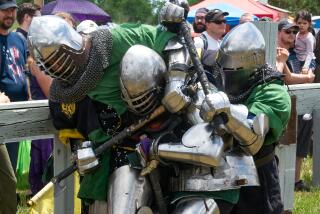For Short Time, Middle Ages Reign Again in the Midwest
- Share via
KALAMAZOO, Mich. — The young scholar with the fresh haircut sat quietly as the professor presented her paper: “From the Cid to the Conquistador to the Jedi Knight.”
Warriors, she was saying, perform essentially the same adventurous role regardless of time or place--or even space. And the Cid’s storied exploits in 11th century Spain were not unlike those of the heroic Jedi knights in the “Star Wars” films.
The professor finished. And the scholar lost it.
“I don’t know if you even saw ‘The Phantom Menace,’ but it’s critical to understanding the Jedi,” he said earnestly. “They’re essentially a police force. . . . I don’t know how you can compare the Jedi to the Cid and the Conquistadors!”
For connoisseurs of the medieval, there is no place like the unlikely place of Kalamazoo--and no time like May, when nearly 3,000 gather from around the world at Western Michigan University to mull such dense topics as the papacy in the age of Otto I or the Ash-Lad motif in old Norse literature. They debate the causes of Norman angst and explore synonymy in 15th century French-Latin dictionaries.
And for one weekend each spring, students of the 5th through 15th centuries turn this quiet town of 87,000 residents and dozens of strip malls on its Midwestern head.
It’s certainly the only time you’d hear conversations like these around here:
“I’d really love to study the lute,” one conference-goer confided to another as a shuttle bus took them past the Bill Brown Alumni Football Center. Or “I’ve a friend who just completed some simply lovely French translations,” remarked another as a group of motorcycles screamed past.
Francois Moyet, owner of the downtown restaurant Francois, prepares sauces for the visiting academics with dried bread rather than flour. He spices the whitefish to the hilt, long a way of preserving meats in times before refrigeration.
Local hoteliers work overtime. So do the bartenders.
“The medievalists love good wine and good beer--and we can’t thank them enough,” said Greg DeSandy of the Radisson Kalamazoo Plaza hotel.
First convened in 1962, the conference has grown into a rite of passage for young medievalists, many of whom present their first papers here. It’s also a must-attend event for many of the field’s preeminent academics.
Over four days last week, 1,700 papers were presented and 562 discussions held--along with two concerts, a film festival and a theater performance of “Murder in the Cathedral.”
Last year, the hot topic at the gathering was women in medieval times--and their generally difficult lot. This year, the theme seemed to be monsters, mayhem and the Old English poem “Beowulf,” whose difficulty is legendary.
Always a favorite of medievalists, if not necessarily high school English students, the 8th century epic details the exploits of the Scandinavian prince Beowulf, his monstrous nemesis Grendel, Grendel’s mother and assorted dragons. It includes the loss of limbs and a lot of blood.
The 1,300-year-old poem has enjoyed an unexpected renaissance thanks to a recent, more accessible--if controversial--translation by Irish poet Seamus Heaney.
The conference saw “Minding the Monster,” “Beowulf: The Critics and the Canon” and dozens of other papers and references, including one that explored how various translations may have contributed to a perhaps skewed, unflattering view of poor Grendel’s mom.
If it all sounds like four days of very big words and very little fun, medievalists are quick to point out discussions on the symbolism of Luke Skywalker’s light saber, on the “bad girls” of Arthurian literature, on the use of sorcery to induce impotence.
“You won’t find a crazier cast of characters anywhere,” said Melodie Harris, 24, a graduate student in medieval studies at Western Michigan who was clad in a blue top, tan skirt and Bugs Bunny slippers. “And I can say that--I’m one of them.”
More to Read
Sign up for Essential California
The most important California stories and recommendations in your inbox every morning.
You may occasionally receive promotional content from the Los Angeles Times.













